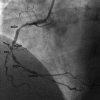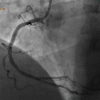A Myth Still Needs to be Clarified: A Case Report of the Frank's Sign
- PMID: 29560293
- PMCID: PMC5856409
- DOI: 10.7759/cureus.2080
A Myth Still Needs to be Clarified: A Case Report of the Frank's Sign
Abstract
Despite advancements in diagnostic tools, physical signs such as xanthelasmata, arcus corneae, facial wrinkles, and gray hair are useful indicators of underlying diseases. The presence of bilateral diagonal earlobe creases (DELCs), also known as Frank's sign, correlates with a myriad of cardiovascular diseases such as coronary artery disease, cerebrovascular disease, and peripheral vascular disease. The use of Frank's sign as a bedside predictor of underlying coronary artery disease is controversial among clinicians. We report a case of a patient with bilateral DELCs found to have significant coronary artery disease during diagnostic coronary angiography for recurrent chest pain.
Keywords: bilateral diagonal ear lobe creases; cardiology; coronary heart disease; frank's sign.
Conflict of interest statement
The authors have declared that no competing interests exist.
Figures
Similar articles
-
Diagonal Earlobe Crease, a Marker of Coronary Artery Disease: A Case Report on Frank's Sign.Cureus. 2019 Mar 11;11(3):e4219. doi: 10.7759/cureus.4219. Cureus. 2019. PMID: 31106102 Free PMC article.
-
Frank's Sign: A Link Between Dermatovenerology, Cardiac Pathology, and Neurology.Acta Dermatovenerol Croat. 2023 Nov;31(2):101-102. Acta Dermatovenerol Croat. 2023. PMID: 38006371
-
Diagonal Earlobe Crease (Frank's Sign): A Predictor of Cerebral Vascular Events.Am J Med. 2017 Nov;130(11):1324.e1-1324.e5. doi: 10.1016/j.amjmed.2017.03.059. Epub 2017 Apr 29. Am J Med. 2017. PMID: 28460854
-
Diagonal earlobe crease (Frank's sign) and increased risk of cerebrovascular diseases: review of the literature and implications for clinical practice.Neurol Sci. 2020 Feb;41(2):257-262. doi: 10.1007/s10072-019-04080-2. Epub 2019 Oct 23. Neurol Sci. 2020. PMID: 31641899
-
Diagonal Earlobe Crease (Frank's Sign) for Diagnosis of Coronary Artery Disease: A Systematic Review of Diagnostic Test Accuracy Studies.J Clin Med. 2021 Jun 25;10(13):2799. doi: 10.3390/jcm10132799. J Clin Med. 2021. PMID: 34202100 Free PMC article. Review.
Cited by
-
Clinical Commentary on an Auricular Marker Associated with COVID-19.Med Acupunct. 2020 Aug 1;32(4):176-177. doi: 10.1089/acu.2020.29152.com. Epub 2020 Aug 13. Med Acupunct. 2020. PMID: 32913483 Free PMC article. No abstract available.
-
Ear Crease Features Are Associated with Complexity of Coronary Lesions.Med Sci Monit. 2020 Apr 13;26:e923343. doi: 10.12659/MSM.923343. Med Sci Monit. 2020. PMID: 32281613 Free PMC article.
-
The Histological Basis of Frank's Sign.Head Neck Pathol. 2021 Jun;15(2):402-407. doi: 10.1007/s12105-020-01205-4. Epub 2020 Jul 25. Head Neck Pathol. 2021. PMID: 32712879 Free PMC article.
-
Frank's sign in anesthesia.Anaesthesiol Intensive Ther. 2020;52(1):72-73. doi: 10.5114/ait.2020.93219. Anaesthesiol Intensive Ther. 2020. PMID: 32090312 Free PMC article. No abstract available.
-
What do Steven Spielberg, Mel Gibson and Emperor Hadrian have in common? Frank's sign and the link with coronary artery disease.Oxf Med Case Reports. 2021 Oct 26;2021(10):omab097. doi: 10.1093/omcr/omab097. eCollection 2021 Oct. Oxf Med Case Reports. 2021. PMID: 34729196 Free PMC article. No abstract available.
References
-
- Aural sign of coronary-artery disease. Frank ST. https://www.ncbi.nlm.nih.gov/pubmed/4718047 New Eng J Med. 1973;289:327–328. - PubMed
-
- Diagonal earlobe creases and prognosis in patients with suspected coronary artery disease. Elliott WJ, Powell LH. Am J Med. 1996;100:205–211. - PubMed
-
- Bilateral earlobe creases and coronary artery disease. Sharma A, Obiagwu C, Sikorskaya E. Cleve Clin J Med. 2016;83:786–787. - PubMed
-
- Bilateral earlobe creases and coronary artery disease. Qamar A, Ioannides KL, Khetarpal SA, Kiss D. Circulation. 2014;130:92–93. - PubMed
-
- Earlobe crease in patient with chest pain. Contou D, Lecronier M, Urbina T, de Prost N. Ann Emerg Med. 2017;69:664–672. - PubMed
Publication types
LinkOut - more resources
Full Text Sources
Other Literature Sources



